Text
Primary Elections in the Village
By Saman Malik

[Voters line up at the PS3 polling site in Manhattan, New York, September 10, 2013. Photo by Saman Malik]
New York City (Sept. 10) - Parents and children flooded into the bright blue doors of P.S. 3, lining up to find their newly assigned classrooms and teachers on the second day of the new academic year. Like many of his classmates, seven-year-old Jaya Tianga found himself distracted by the activity in the auditorium. “What’s this?” he asked his mother.
“Voting,” said Elise Perelman.
“For what?” he asked, curiously peering in through the wide-open double doors.
“For the city,” she answered, while rushing him towards the growing line.
New Yorkers went to the polls on Sept. 10, to vote for the city’s mayoral primary race. Polls opened at 6 a.m. and were due to close at 9 p.m.
Accountant Conon Green, 43, who lives in Soho, said he is optimistic for the results of this election. “Hopefully the new mayor comes in and that will change things,” he said. “[We have to] let them know that our schools are just getting bigger with fewer funding and that has to change because these kids are going to be our future leaders someday.”
“I would like to see some change,” said Perelman, 36, reflecting on the education system.
However she said she doesn’t foresee it happening. “It’s such a big city, there’s a lot of bureaucratic problems - a lot of problems of money and I don’t know that education is going to be on the top level.”
The return of the clunky dark-grey lever voting machines was also a topic of concern and conversation for many. Unlike voters at other polling stations across the city, those who cast their ballots at P.S. 3 said they did not experience any problems with the old machines. “I am happy that we have our dopey old machines back rather than the paper,” said Alexandra David, 70, a bookkeeper and longtime resident of the West Village. “I didn’t like the little paper ballots, but I think we should be voting by computer - this is so archaic.”
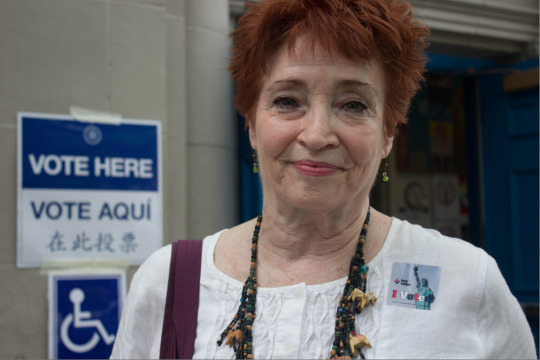
[Voter Alexandra David, proudly sporting an “I Voted” sticker, outside a polling site in the Village, New York, September 10, 2013. Photo by Saman Malik]
Several voters like David, who come out to vote every year said they don’t expect things to change significantly following these elections. David said she doesn’t expect this election to bring about a significant change. However, she said she tries to keep things in perspective. “This is a very nice neighborhood,” David added. “There are other neighborhoods that need attention more than ours.”
Jack and Helen Katz, 83 and 76 respectively, have lived in the neighborhood for 45 years and come out to vote every year. They said they were overwhelmed by the number of people running in the elections – and unnerved by the negativity of the campaigns “Elections used to be more gentlemanly,” said Jack Katz. “[Now] candidates don’t respect one another. It’s anti-people.”
Sitting on the sidewalk across from the school, Courtney Borg, 35, a superintendent said he is not interested in the voting process. “They’re all a bunch of crooks - from Washington down,” he said. “They don’t care about you. That’s why they will never see my vote. All of them - Democrats, Republican - I don’t care about them.”
0 notes
Text
For Many, Access-A-Ride is “Stress-A-Ride”
By Saila Huusko
On a sunny September morning, Mary, 79, had a doctor’s appointment. She dutifully came outside her Astoria home to wait for her ride at the time she had been told to be there. It was 10:17 a.m. Mary sat on a bench in her elegant blue outfit, following each passing car with her gaze. Over half an hour later, she got a phone call. Her car would be there at 12, the dispatcher said; an hour and a half later than the agreed time. She decided to take a taxi. “I never got another call until I called them to complain,” said Mary, who asked to be identified only by her first name. By them, she meant the Metropolitan Transit Authority’s service for people with disabilities, Access-A-Ride.
For most, calling a taxi every time the service fails to ”serve” isn’t financially viable. Besides, said Mary, by the time you’ve waited for a long time, it may already be too late to make a scheduled activity. That day, she was lucky, as her doctor’s appointment was not at a fixed hour. “Otherwise I would have missed it. He would have been gone already, because that was an early morning office for him,” Mary said.
As Mary waited for her ride that day, several neighbors who passed by commented that she might wait all day. Chances were, they said, Access-A-Ride might never show up to get her. This skeptical attitude seems all-pervasive among users.
In a city like New York, accessible and timely transportation is key to a good quality of life. Arriving late to a doctor’s appointment or, say, a meeting with a lawyer can have serious consequences. For those with disabilities, arranging transportation requires more than a simple walk to a subway stop.
The Americans of Disabilities Act (ADA) of 1990 mandates that any entity - like the MTA - that provides public transportation on fixed routes also provide comparable service to people whose disabilities prevent them from accessing the regular buses and subways.
According to Deirdre Parker, an MTA Press Liaison, there are currently nearly 164,000 registered users of Access-A-Ride in New York City. “The majority of trips are door-to-door,” Parker said in an email. There has been a 5% decrease in the number of users since 2012, a change that Parker attributes to “more objective eligibility determinations,” meaning a stricter selection process of who actually qualifies for the service.
According to Access-A-Ride’s website, the eligibility is determined by filing an application, followed by attendance at an interview and a possible functionality test at one of the assessment centers. Dorothy, 77, has used the service for two years. When she first applied for the service, she said, she could hardly walk. She still remembers the assessment; stepping on the bus, and stepping off it. “You have to be really almost out of it before you get Access-A-Rides,” she said. Now, it may be even more difficult to qualify.
Dorothy, who also asked to be identified only by her first name, is familiar with Mary’s experience. An Astoria resident, she uses Access-A-Ride four times a week. One day, she was coming out of dialysis when her confirmed Access -A-Ride back to her home appeared - but only briefly, she said. “I have to walk slow, because when I come out of there my whole body’s turned upside down,” she recounted. “I was walking, and holding on to the building to get to the curb, and he pulled off.” As the driver left, she said, he called his dispatcher to say that Dorothy had been a no-show. “That was a lie,” she said angrily, “that was a lie.”
Yet, according to the MTA’s Deirdre Parker in her email, the rate of complaints has decreased since 2012. She wrote that in August 2013, the rate of complaints was 1.33 per every thousand rides – a relatively small number for a massive amount of rides. In 2012, the same number was 1.43.
People like Dorothy who do register a complaint say that, often, problems arise from bad communication with the drivers, as well as their behavior once in the car. Dorothy recounted an incident where she was dressed up and sitting in front with a driver, who was eating, which bothered her. “Then he gets on the phone and he’s running off at the mouth with somebody else. That’s not right, you know. And he’s scaring me,” she said. “I’m up there, holding on to the handle, because he’s going real fast and he’s beating the cabs.” Dorothy said that time the vehicle was not one of the familiar blue-and-white Access-A-Ride buses, but a black car, a private service working under a contract with the MTA. They’re the ones who cause the most problems, she said.
Passenger Patricia Hill, 72, agreed that the private car companies often have drivers who do not know how to treat the passengers. “Some of those black car services are very nasty, and Transit is paying them,” Hill said. She has also called to complain on several instances. “You have a lot of them, they speed in traffic and I don’t like that,” said Hill, who has used Access-A-Ride since 2003. ”They have a job helping people,” Hill said, ”you wanna go to the church, you wanna get down there in one piece. You wanna visit your daughter, you wanna see her before you wind up in hospital,” she continued. ”I make jokes out of it but it’s serious, it’s really serious.”
According to the MTA’s Deirdre Parker, the black car service or “non-dedicated transportation” accounts for about 30% of annual Access-A-Ride trips. She said that the contractors are provided with specific customer feedback and complaints. Although complaints have gone down, Parker concedes that the MTA is “aware that car service and taxi drivers must make a better effort in customer sensitivity and service.”
Daniel Aliberti, former president of the Queens Independent Living Center, believes that many incidents slip through the cracks because people feel that complaining does not help. It goes on so often, he said, that users feel that the administrators must know about it. “It’s the feeling of helplessness that is prevalent throughout the community of disabled people. And elderly people too,” Aliberti said. When people depend on Access-A-Ride for their transportation, fear may also play a role in their decision not to complain. Mary and Dorothy’s request to use only their first names stems from such a fear of repercussion.
Dorothy said that fighting and complaining can get tiring. ”I’ve fought more with Access-A-Rides than I do anything else,” she said. But despite her bad experiences, she gave Access-A-Ride credit for being there. ”One good thing about them,” said Dorothy, ”is that they take you wherever you wanna go.”
Patricia Hill agreed. She said she strives to understand the drivers and the time pressure they are under. Hill believes that customers should be mindful that anything can happen on the road. For her, the service provides a chance to see her family. “I hear these little stories but I still cannot knock the Access-A-Ride, because in my book, it’s a blessing. It really is,” she said. ”But it is a stress-a-ride in a way,” she continued, laughing.
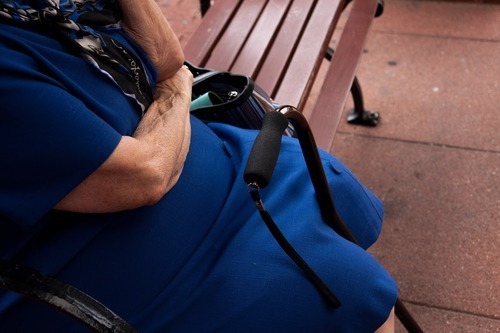

0 notes
Text
AND...SCENE: Astoria
By Saila Huusko
Walking into the Bohemian Hall and Beer Garden is to be transported to an unpretentious countryside hotel in Central Europe. There is brown wooden paneling on the walls and bar tables provided by beer brands. Nothing extraneous. Above the bar, there are four flatscreen TVs, all tuned into football. The TVs’ sound is replaced by a German radio channel blaring remixes of pop songs. It must be night radio; disc jockeyed by a computer in an unmanned studio.
The courtyard outside is almost the size of a tennis court. With forty people scattered across the space, it looks empty. Gravel grinds underfoot. A weak odor of grilled meat wafts from the open-air kitchen. It is swept away by the chilly September wind that twirls between the trees.
The customers divide according to their chosen sport. In one corner they watch football, tennis in others. The groups have their backs turned on each other.
Small American, Slovak, and Czech flags on the walls circle the courtyard. During the hundred years of the garden’s existence, these flags must have changed to reflect the shuffling of regimes back in the motherland. Bohemia, Austro-Hungary, Czechoslovakia and, now, Czech Republic and Slovakia.
There is a couple having dinner. They are both staring at their cell phones until the food comes out. The young woman is wearing a short dress. It is too little for the chilly evening. Perhaps she is an optimist in denial of the inevitable end of summer. Maybe she is coming straight from work.
Light chatter, the occasional eruption of sports cheers, and the sighs of the wind in the trees create a peaceful soundscape. A passing train rumbles in the distance. Tennis has ended. Now the oversaturated face of Ashton Kutcher fills the screens.
Light from the TV casts colors on the faces of two young women. They sit opposite each other. One of them is pouring her heart out. She is wearing black skinny jeans that are ripped to reveal her knees. She rambles in long, indefinite sentences and draws sharp breaths in between. “It’s not like I’m gonna kill myself or anything,” she says. Tragic romance. Her friend listens patiently and tries to cut in every once in a while. She has no luck. She manages to utter single words before her friend bulldozes her attempts. The heartbroken woman stands up to buy more beer. As she walks away, her silenced friend hangs her head, draws a deep breath, and lights up a cigarette.
0 notes
Photo
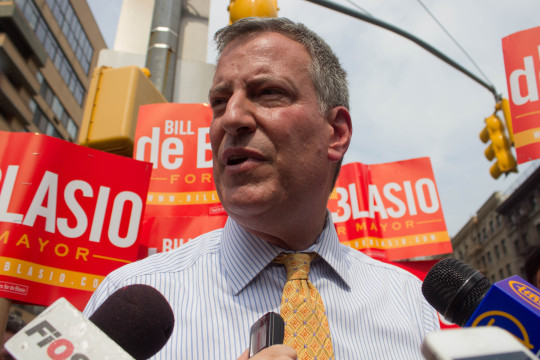



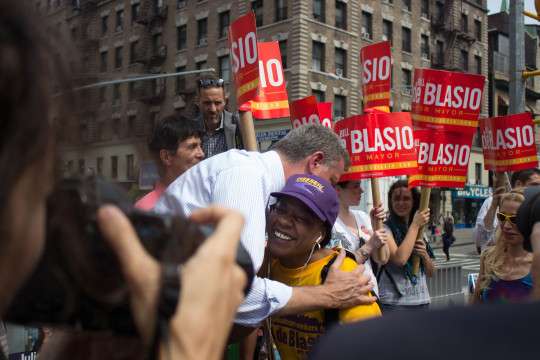


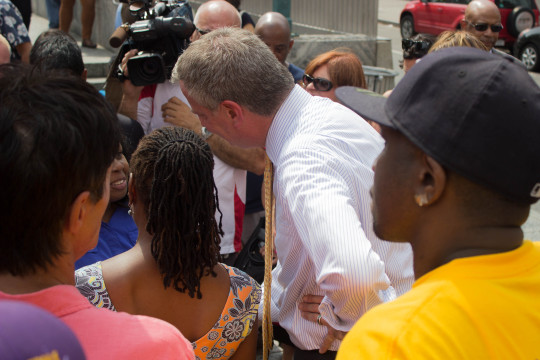


[Democrat Bill de Blasio elected NYC mayor]
Bill de Blasio was elected New York City's first Democratic mayor in two decades Tuesday, defeating Republican Joe Lhota, for the job.
On Sept. 10, 2013, the day of the primary elections in New York, De Blasio, 52, greeted afternoon commuters outside the 96th Street subway stop in Upper Manhattan.
0 notes
Text
Closing hospital ‘home’ to patients, demolition a ‘shame’
By Deepashri Varadharajan
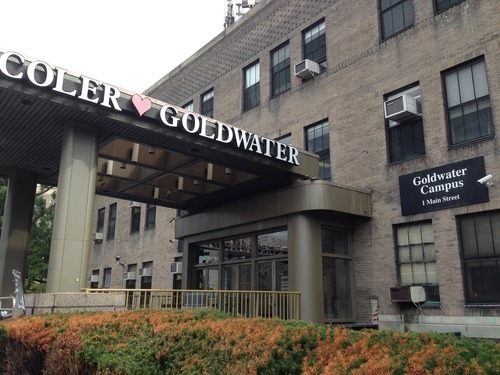
[Hundreds of disabled patients were residents at the island's Goldwater Hospital campus that will soon shut down.]
Jim Bates rode his bright blue electric scooter on the one lane blacktop street along the East River on a sunny fall afternoon, pointing at the disabled-friendly swimming pools, gymnasium and stores on the way. “The sidewalk is bumpity bumpity bumpity, and I feel every bump,” he explained, enroute to visit the site where a new monument of President Franklin Delano Roosevelt will soon stand. Or rather sit. It will be a statue of Roosevelt in a wheelchair, greeting a disabled child.
Roosevelt Island was named so for a reason.
“It's probably one of the largest communities of disabled people located in one place. The island is the most accessible place I've ever seen in the United States,” said Bates, 68, president of the Roosevelt Island Disabled Association. Bates was disabled 11 years ago after a softball injury and a failed knee surgery. He moved to the island in 2001. His friends suggested the place for its ease of access.
Sometimes Bates’s mini scooter must trace a circuitous path — motoring up and down from sidewalk to street, via the special dips in the curb, one of the many features that make Roosevelt Island so wheelchair accessible. An almost unnoticeable sticker on the scooter’s rear bumper read, “Pride.” “Enabled Not Disabled” was printed in black on a sky blue shirt hung on his seat.
There are nearly 200 physically “enabled” residents on Roosevelt Island, Bates said, but he isn’t counting hundreds more, a disabled population who for decades have occupied two residential hospitals - at opposite ends of the island - now jointly called the Coler-Goldwater Specialty Hospital and Nursing Facility.
For many patients with severe physical disabilities at Goldwater’s rehab facility, the hospital—and the island—have been their home for several decades.
Until last year, when the decision was made to relocate over 800 patients to other hospitals across the city by November of this year. Once they’re all gone, the Goldwater campus will be demolished in 2014, to give way to the construction of Cornell NYC Tech campus.
“I know no more society,” said Harriston Fullerton, who was a resident at Goldwater Hospital for 23 years, until it was “taken away” from him this June. “I prefer to die on the island.”
Fullerton, 66, rested his legs on the foot of his electric wheelchair, looking at the tall buildings across the river. He has witnessed several of them sprout in recent years, he said. “We people in the wheelchair belonged to this island in the 90s. It’s sad they’re taking it away from us.”
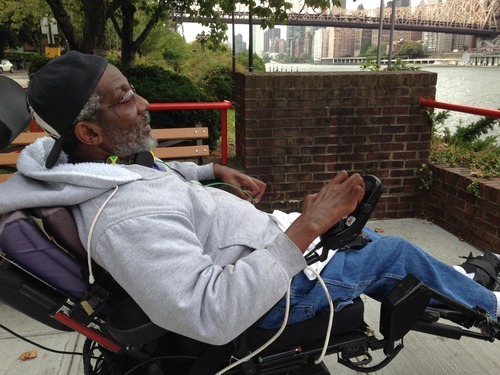
[Patients like Harriston Fullerton, who have lived at the hospital for decades, call the demolition a shame, and hope someone can help them.]
Judith Birdy, who sits on the Coler community advisory board, characterized the patients – suffering from polio, multiple sclerosis and other conditions that required long term care or rehab.
“The staff at the hospital were their friends,” Birdy said. “People are upset because they have lived there a long time.” A majority of them were there because their families couldn’t take care of them, she added. “They have been thrown out now.”
Birdy said a lot of patients there had drug or alcohol problems, no proper documentation, social issues, and psychiatric or psychological problems. “Other places won’t take them,” she said.
"These people have issues that make it difficult for them to get housing—immigration issues, some have past criminal justice issues, no family, no income,” said Margi Trapani, communications director at Centre for Independence of the Disabled, New York. The organization had a contract with the hospital earlier to inform patients about their transition from one place to another.
Some patients have been shifted to the Coler campus, but many who need intense care will go to Henry J. Carte Specialty Hospital and Nursing Facility on Madison Avenue, Birdy said. Others were shifted to hospitals outside the city or went to live near their families, she said. “Private hospitals don’t take them if they don’t have Medicaid.”
Harriston Fullerton can not hold a pen to write his name down. His fingers are bent inwards. He used his finger joints to direct his wheelchair. He is one of the lucky ones. He and his friends were shifted to Coler Hospital, and will remain on Roosevelt Island. With a grey sweatshirt to guard against the cold breeze and his black cap turned around, he was on his way to meet someone at Goldwater hospital, which, according to him, is one of the best nursing homes in the country.
He said he had met people from different parts of the world during his stay at the hospital, but he doesn’t know where they will end up now. “It’s a sad day,” he added.
What he likes most about Roosevelt Island is the freedom to be able to go anywhere he wants to and still feel safe. “There’s no accident with no car,” he said. He felt bad for those who will have to leave the island.
“It is a shame that Goldwater is going down and some of us have nowhere to go. I hope somebody can help us,” he said.
The patients at the hospital are not the only ones who are unhappy.
Emotions run high on the island over the plan to demolish Goldwater Hospital and construct a university in its place. According to a 2011 press release from Mayor Bloomberg’s office, the city will provide $100 million towards the construction of the university, which will expand to over 1.3 million square feet on the island by 2027. Many residents have vainly opposed the proposal.
John Fraher, 60, has been living on the island since 2001.
“We have some people that have been in the hospital 20 and 30 years… heavily handicapped people, and it was unfair,” he said. “That’s Michael Bloomberg, ‘Do whatever I want, not what’s a good idea.’”
“People can’t be ignored. Cornell is just like any other corporation. It’s a private institution; it is not a public school. You wouldn’t qualify to go to it; neither would I, because we couldn’t afford to go to it. That’s the bottom line on it,” he said.
But Matthew M. Katz, former president of the Roosevelt Island Resident’s Association, said it was a given that Goldwater Hospital would be emptied years before Cornell was even on the horizon.
“It was built in the 1930s. We have been talking about the closing of Goldwater Hospital for four, five years now,” he said.
“For people who are disabled, people who are living their lives in a residential hospital, this must be very traumatic,” he said. “But it’s the way it is. There’s nothing we can do about it.”
For patients like Harrison Fullerton, though, it’s a bitter pill to swallow.
“It is a disgrace. That’s all I have to say,” said Fullerton.
0 notes
Text
One Shelter’s Struggles Are A Neighborhood’s Nuisance
By Sean Ryon
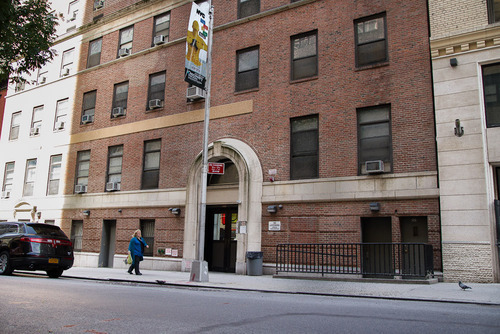
[The New Providence Women’s Shelter is a homeless shelter for women suffering from drug addiction and mental illness in Turtle Bay. Community members said the shelter’s presence in the neighborhood has led to an increase in crime.]
It started out as a typical spring evening for Arturo Paulino, manager of the Amish Market on E. 45th St. and Second Ave. He was stocking the store’s shelves with artisan cheeses and soy cereals when he caught a woman trying to steal a bottle of honey. Paulino headed off the thief and demanded the honey back. The woman whipped out a Swiss Army knife, Paulino later recalled, and waved it around dangerously while spitting profanity-laced threats.
Paulino didn’t have to look far to find his assailant. She was his neighbor, a resident of the New Providence Women’s Shelter located right across the street from the Amish Market. Although he walked away uninjured, Paulino was shaken, and said he didn’t report the 2010 incident to police because he feared doing so would make him a target.
“Some of [these residents] can get really, really tough,” he said. “The lady that assaulted me, I had to save my life. These are people that will kill you.”

[Arturo Paulino, the manager of the Amish Market on E. 45th St. and Second Ave., said one shelter resident attacked him with a knife in 2010. He said he didn’t report the incident to police for fear of retaliation from the assailant.]
Residents and business owners in Turtle Bay said the New Providence Women’s Shelter has posed a problem for over a decade. This past summer, however, community members said they witnessed a sharp increase in the number of criminal incidents taking place. Many locals said they believe a lack of a police presence is to blame for the continuing predicament. The CompStat breakdown of crime in the area reflects this trend. The 17th Precinct reported grand larceny and robbery rose by 5% and 28.9% respectively in the past year.
This increase came at a time when the 17th Precinct underwent a decrease in personnel. Deputy Inspector James Sheerin said in a recent community meeting the station experienced a drop in manpower due to the high attrition rate of retiring officers. At the same time, he said the precinct suffered from a smaller class of graduates from the police academy this summer. The academy saw a 39% decrease in the number of graduating full-time uniformed officers from July 2012 to July 2013, according to Mayor Bloomberg’s office. Sheerin said this shortage has prevented the precinct from delegating a Parks Enforcement Patrol to monitor the areas around the shelter.
Jose Rubero, a security guard at the Dag Hammarskjöld Park on E. 46th St. and Second Ave., said the lack of a police patrol has caused a number of problems in the area. He said the park and adjacent plaza on E. 47th St. have become a hotbed of drugs, drinking, defecation and even public sex in the absence of police. “They urinate in the bushes, they're constantly begging,” said Rubero.
“It gets pretty bad. It's scary because you don't know what's going to happen to them.” The New Providence Women’s Shelter made Turtle Bay its home in January 1998 after it moved from E. 55th St. and First Ave. The shelter houses 130 homeless women suffering from mental illness and drug addiction. It also operates as a fully licensed medical clinic for its residents.
The shelter’s move to the area was met with controversy when it was first announced. Panos Adamopoulos, the board director of the 240 E. 46th St. building, said multiple community members assured him the shelter would not relocate to its current location.
“The problems that are being created are overwhelming not only for the residents, not only for the managing agents or that chapter, not only for the police, not only for the hospitals or the ambulances,” he said. “Every single thing has been stretched to the limits.”
Five years ago, New Providence began drawing criticism from more than just community groups. The New York Times reported that four shelter residents had run afoul of the law leading up to August 2008. The shelter later made headlines in October 2011 when police shot and killed one of its residents after she attacked officers with a knife.
Adamopoulos said crime in the area was at its worst in 2006. That’s when he teamed with realtor Kathy Thompson and Denise Strong of A&E Networks on E. 45th St. to form the East Side Community Alliance.
“We found out that the quality of life was really lacking in our neighborhood,” he said. “Despite all the assurances, there was not really any security or supervision or any thought as far as that part of Manhattan.”
Adamopoulos said the alliance did see some initial improvement during 2010 and 2011 when security cameras were installed above the shelter’s entrance. He also said the managing agents of the Dag Hammarskjöld Condominium and 240 E. 46th St. buildings began to pay $12,000 annually for a paid police detail to monitor the parks over a period of three years.
“It is unfair to our community,” he said. “We should be feeling safe and secure and be safe and secure by whatever means the city had to provide us without extra cost to us.”
The change was short lived, however. Adamopoulos said problems with the shelter quickly remerged and have only gotten worse in recent months. In the wake of the economic recession, Adamopoulos said funding for the paid detail evaporated in 2010.
Dimitra Gianacopoulos, the director of the New Providence Women’s Shelter, recently spoke to community members’ at a Community Board 6 meeting for the Housing, Homeless and Human Rights Committee in early October. She said the shelter has been working with the 17th Precinct and Community Board 6 to investigate community members’ complaints. After the meeting, she declined to comment further.
Many residents said they don’t see the shelter crisis getting better anytime soon. James O’Donnell, a banker who lives in the 240 E. 46th St. building, said he’s watched intoxicated shelter residents stumble up and down the block and pass out in piles of garbage.
“[The shelter needs to] make sure they’re not intoxicated or taking narcotics,” he said. “They’re being disruptive in the area.”
Not all community members harbor negative feelings towards New Providence. Ira Freehof, the owner of the Comfort Diner on E. 45th St. and Second Ave, said he supports the shelter’s efforts.
“[The residents] need the shelter,” said Freehof.
Community Board 6 has already begun responding to locals’ concerns. Last week, the board passed a resolution requiring the Department of Homeless Services to provide notification when sexual offenders move into a shelter and when a family shelter is converted into an adult shelter. Despite these measures, Paulino said he’s skeptical of the outcome.
“The rich folks can’t do nothing about it,” he said. “It’s got to be something like teamwork – community, business, and everybody together.”
0 notes
Text
Last Men Standing On Pier 17
By Jasper Rischen


[John and Joseph Demane refuse to vacate their restaurant “Simply Seafood” in the Pier 17 mall building, which is slated for demolition. Father and son claim they have a lease until 2020. Photo by Jasper Rischen, October 2013.]
Throughout the deserted Pier 17 building, the lights were out and entrances shuttered. Only one door of the main entryway remained accessible. Security guards discouraged people from entering the doomed building, unless you uttered the magic words: “I’m here for Simply Seafood.” Then the guard would sigh and knows he couldn’t refuse you, murmuring, “go ahead,” as he stepped aside.
All the way up on the top floor, in a corner of the food court, a few lights still burned. Laughter from a handful of customers echoed onto tall metal ceilings and down long halls of the otherwise empty mall. At Simply Seafood, steam rose as John Demane, 69, threw white flounder into sizzling hot oil. The cash register made a ringing noise as Joseph Demane, John’s 42-year-old son, checked out a customer. “Thank you sweetie, salt and pepper is on the end if you like,” he said. Customer Tatiana Bliss, a 42-year-old writer visiting from California, gasped as Joseph Demane explained his situation to her. “Oh my gosh, what an amazing story!” she exclaimed. “I’m so glad to be your patron here; it’s like a David and Goliath story!”

[A guard blocks the entrance to Pier 17. A sign reads, "Shop are closed, except for "Simply Seafood." We apologize for any inconvenience this may have caused." Photo by Jasper Rischen, September 2013.]
It is the classic tale indeed, this time of a little business battling a giant corporation. In this story though, a simple stone won’t hand the underdog a victory. Rather, an eight year long lawsuit with many frustrations on both sides will climax within several days or weeks, in a battle that reflects tensions roiling between development forces here in New York, and the neighborhoods they seek to reconstruct. The Pier 17 mall building has been almost completely empty since September: first steps of demolition have already begun. But, the Demanes alone refused to leave the building, claiming their lease runs until 2020. Son Joseph said the leases were wrongfully terminated after a new developer took over in 2004. The Demanes are one of 16 business owners who’ve been fighting this in court ever since; the others vacated in 2010. The otherwise abandoned barn-like structure of bluish-grey steel and red sheet metal is scheduled to face wrecking balls any day soon. Pier 17 will reopen in 2015 as an all-glass structure featuring a public rooftop with a concert venue, and a new mall with “upscale retail,” according to the developers’ website. The only thing frustrating a $200 million dollar redevelopment plan – some publications even use a $340 million figure - is Simply Seafood.
The three-story Pier 17 building at the South Street Seaport first opened in 1985 to house more than 120 stores and restaurants. The Seaport is a collection of historic buildings overlooking the East River at the southern tip of Manhattan. It was once the gritty portal for New York’s fish industry, but now it’s mainly a tourist destination. A couple of colossal sailing vessels recall the old glory days as they tower over the Franklin D. Roosevelt Drive, which cuts right through the area. But the famous fish markets have moved to outer boroughs – their spaces snatched up by developers and chain stores. The Pier 17 mall was part of the first wave of commercialization in the area – to find itself outdated not even three decades later. The building, which blocked a view of the nearby Brooklyn Bridge and gradually suffered declining visitor numbers, had long been an eyesore to locals and developers alike. Previous attempts to shut the mall down foundered when a developer went bankrupt during the 2008 credit crunch.
Then came Hurricane Sandy, which severely damaged the area. “Frankly, it’s still a mess,” said Diana Switaj of Community Board 1, pointing out that many Seaport businesses were still closed. But, surprisingly, local residents and business owners said that while most of the Seaport was ravaged, storm damage to Pier 17 itself remained minimal. The pier building rested on a higher level than the rest of the Seaport. It became “like an island,” during the storm, said fish fryer Joseph Demane, with water flowing around it onto the lower Seaport areas. “There was water everywhere, but here it was as dry as a bone,” Demane said. Still, the current building leaseholder, a Texas-based developer, the Howard Hughes Corporation (HHC), opted to tear down the much derided structure. “Sandy was probably their best friend,” said Joseph Demane. “It allowed them to get people out without paying them,” he added.
Father and son now keep their restaurant open from exactly 10AM every morning, until 9PM at night - preparing crab sandwiches, red snapper salads and their bestseller: fried fish and chips. If they open even a minute late or go home a minute early, their attorney fears the landlord could claim that they’d improperly “vacated their business.” Joseph is the one staking out the restaurant most days, while his father John attends court hearings. Customer traffic is slow, leaving Joseph to kill many boring hours by himself. “It’s just as hard as working hard, believe it or not,” said Joseph, a faint smile on his friendly face. His gray eyes looked serious as he tapped himself a crisp beer after one of those dragging days. “Its painstaking and you worry about stuff and about what’s happening with your future,” he said. “It wears on you.” The Demanes hope a judge will rule in their favor soon – or at least some kind of settlement is reached. “I’ll fight,” said a defiant Joseph Demane. “I didn’t come this far to just walk up there and hand in my keys. If I win, I win, and if I lose, I lose. But at least I’ll sleep at night knowing that I did what I could.”

[Two tourists from Japan have lunch at "Simply Seafood," in the otherwise deserted mall. Photo by Jasper Rischen, October 2013]
Grace Espana, a 76-year old born-and-raised New Yorker, took a bite out of her golden brown Fish & Chips as she admitted that eating in an empty mall was rather odd. “I feel like I’m in the twilight zone,” said the frail Espana, her white hair in a loose bun, “It’s like a bomb has dropped and I’m the only one alive!” Behind her, John Demane had just arrived from court, which was on lunch break. Standing near the counter, he recalled a story from earlier that day. The judge had tried to convince both parties to settle, and Demane claimed that a representative from the Howard Hughes Corporation (HHC) later whispered to him in the hallway of the court, “You’re not going to get anything from us! Not even 50 cents!” Through a spokesperson HHC said that nobody on their side had discussed settlements directly with Mr. Demane or any of the other plaintiffs. The spokesperson did say however that HHC representatives had told the shop owners’ attorney that they would consider a settlement in which they would forgive all the amounts that the plaintiffs owe them, but that “under no circumstances” would they pay them any extra; “not even $1”. With that offer turned down, HHC said they expect “to be awarded in excess of $10,000,000 against the plaintiffs,” stressing that Demane and his co-plaintiffs “will in fact receive nothing.”
The trial has now been in court more than 50 days since the case arrived at Manhattan’s Supreme Court. HHC’s team of defense attorneys comes to court well prepared. On one recent trial day they presented a slick PowerPoint with titles like “Mr. Demane’s Credibility Gap.” It swept through different clauses of the lease, pointing out multiple discrepancies between the lease and statements Demane had made during the trial. HHC lawyers spoke of “mystery (rent) checks” that never arrived, painting a picture of Demane as “a tenant who was a chronic non-payer and late-payer by his own admission.”

[John Demane attends every court case in their trial against the landlord, as his son Joseph keeps their restaurant running. When the court is on lunch break, the senior Demane walks back to Pier 17 to help out. Photo by Jasper Rischen, October 2013.]
John remained calm during the defense attacks, shaking his head every now and then as he rested his arms on the side of a wooden visitors bench. The short v-neck of his blue sweater revealed the tip of a grubby white t-shirt. His Nikes showed a similar tint as he crossed his legs. When the judge called for a break, Demane said he was doing fine. “It’s not stuff I hadn’t heard before. A lot of it is half-lies.” Back in session, his attorney seemed much less organized than HHC’s lawyers. A few other storeowners who had filed the lawsuit with Demane were there to support him, their blue jeans contrasting with the sharp suits on the other side. “They wear us out,” said Gerry Nally, who once had a watch company in the Pier 17 building. “They spent so much money fighting us,” he said bitterly.
The weekend before, a community organization called “Save Our Seaport,” held a rally in the shadow of the Seaport’s Titanic Memorial Lighthouse. Speakers struggled to get the microphone working – often resorting to an old-school megaphone – as about 80 local residents and community leaders gathered to talk about HHC’s general approach to the neighborhood. “We cannot forget, we’re talking about public property here,” said Robert LaValva of the local New Amsterdam Market. “They are a tenant - not an owner - of city owned property,” he stressed. HHC indeed does not own any of the Seaport area, but has leased it for the next 60 years from the city. As far as community leaders like Jenifer Rajkumar were concerned, that was one of the many reasons HHC had to remain accountable. “Howard Hughes is not transparent; they don’t let the community know what their plans are,” said Rajkumar. LaValva added, “They have been extraordinarily secretive with their plans, and that’s what makes the community more angry than anything else.”
Adding to the community’s fury were multiple audit reports from City Comptroller John C. Liu, which declared HHC had underpaid almost $1.8 million dollars in rent for the Seaport. The Comptrollers Office said they did not know whether the money had been repaid yet. The Economic Development Corporation, the city agency that is charged with overseeing the leasing of the Seaport to HHC, responded that they had verified the underpayment of rent, but added that after a litigation procedure against Howard Hughes all issues had been settled in court in October 2010. However, in his most recent audit report of July 2013, Comptroller Liu said that the outstanding payments had been calculated wrongly and he expressed suspicion of the EDC’s handling of the lease, writing, “the EDC has ceded management of it [the Seaport] to a company [HHC] that has shortchanged on its rent checks.” A spokesperson for the Howard Hughes Corporation said they are “extremely disappointed” with the announcements by the Comptroller’s Office and “reject their findings.” Liu’s office said it is not their task to reinforce payments, but EDC’s. The EDC did not agree to pursue the extra amount of rent that Liu had calculated.
For John and Joseph Demane, their dispute over rent checks was most likely going to mean the end to a 70 year long family fish business. Joseph Demane said the best-case scenario would find Simply Seafood in a spot in the new building, but admitted that seemed unlikely. In a statement, HHC called Simply Seafood an “illegal, hold-over tenant,” and the lawsuit a “long and arduous process.” They assured that the redevelopment process was “moving ahead as planned.”

[To keep their lawsuit viable, the Demanes say they open “Simply Seafood” every morning at 10 a.m. sharp in the otherwise deserted mall, and don’t leave a minute before 9 p.m. Photo by Jasper Rischen, October 2013.]
However the trial ends, John Demane said he couldn’t wait for it all to be over. “Actually I’m going to be very happy to watch the pier come down. It’s been a very frustrating eight years,” said a visibly weary Demane Sr, who had retired to Florida in 2000, but returned to New York while the lawsuit dragged on. “It takes its toll. Outside of just losing your business of three generations, I’m not going to be that sad to get out of here, and go home,” he said. Son Joseph remained more adamant and intended to challenge the corporation as long as possible. “They probably will have to call the cops and arrest me, because I wont give in easy,” he said, rubbing his eyes as he weighed his words carefully, yet vehemently. He turned off his frying pans, finished for the day. “They will have to drag me out of here.”
A ruling on the case is expected for late October or early November. Meanwhile, gutting of the Pier 17 building continued at a slow, but steady pace.

[With the occasional lunch rush aside, customer traffic is slow in the deserted Pier 17 building, leaving John and Joseph Demane to kill many dull hours by themselves. Photo by Jasper Rischen, October 2013.]
1 note
·
View note
Text
History Eludes Transgender City Council Hopeful
By Olivia Crellin
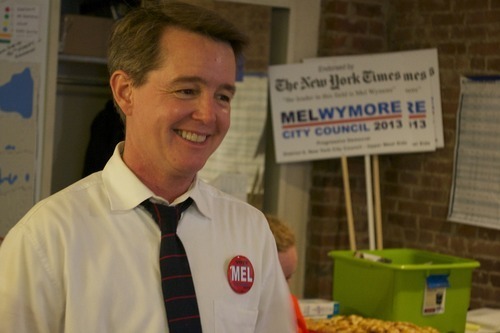
[Mel Wymore, would have been the first elected openly transgender politician in the U.S., had he won the council election primary in September. September 10th 2013. Photo by Olivia Crellin]
Mel Wymore’s quest to become the City Council’s first openly transgender member was derailed Tuesday when he was beaten by fellow Democrat Helen Rosenthal.
“We set out to change the conversation around politics,” Wymore said in an email after the results were announced. “We came in a close second, but we accomplished a lot and inspired many.”
One Upper West Side resident, Mark Dooley, 53, a personal trainer, said he was relying on Mel Wymore “to keep the neighborhood and the people who made it from being overrun by developers.” Wymore, who has been a member of the Upper West Side Community Board for almost two decades, chose to refuse “without prejudice” all campaign donations from real estate companies and political action committees. The decision evidently impressed voters like Dooley.
Gender politics – Wymore’s most distinctive feature - were, however, conspicuously absent from the system analyst’s shortlist of canvassing priorities: the fact that Wymore was transgender was not even mentioned on the candidate’s website.
“We have chosen to walk a very nuanced path around my candidacy,” Wymore said in an interview at campaign headquarters. “My campaign is 100% about my record, I do not ask people to vote for me because I am transgender. However, I am open and honest about who I am and I understand how powerful my candidacy is to a number of people in the world.”
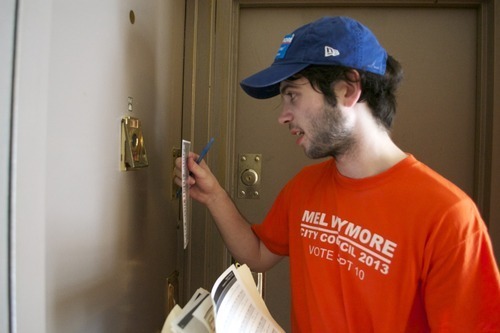
[A young campaigner canvasses door-to-door for Wymore right up until the final hours of election day. September 10th 2013. Photo by Olivia Crellin]
One inspired fan of Wymore’s is not even eligible to vote for Wymore. Still, Sarah Spohn, 44, an IT consultant from Philadelphia, travelled all the way to New York to support the campaign. “His policy on limiting storefront widths to 50 meters to protect mom and pop businesses really sold Mel’s campaign for me,” she said, giggling. “That and the trans thing.” Until last year Sarah had been living as a man.
Despite support from this demographic coming from as far afield as Florida, the strategy to play down Wymore’s transgender status seemed successful: many voters on Tuesday on the Upper West Side did not even realize there was a transgender candidate.
“I’m all for whoever wants to run, whatever group, whatever preference.” said voter Kesta Joseph, 29, when told that there was a transgender candidate in the City Council race. “If a homeless guy wants to run I’ll support him if I think he’s the best man for the city.”
Identity politics, or rather a case of mistaken identity, may have played a pivotal role in deciding Wymore’s fate, according to his campaign.
Rosenthal, who scooped up more than 27 percent of the vote while Wymore received a little over 22 percent - despite receiving an official endorsement from the New York Times - shares her surname with New York State Assemblywoman Linda Rosenthal. According to Wymore candidate sources, this may have had an impact.
“I’ve spoken to some voters who said that they had voted for Helen confusing her with Linda,” said Wymore’s campaign manager, Jordan Jacobs. “Linda had even come out and tried to clarify the situation herself.”
When reflecting on the narrow loss, Wymore was positive. “Paradigm shifts take time and multiple layers of communication,” he said. ““If another political opportunity comes up, my mind and my heart will be open.”
1 note
·
View note
Text
An Angelic Remembrance
By Olivia Crellin

["He loved fairies, he loved trains, he loved the beautiful things in life." Signs ask mourners and passers-by to take a magical charm from the table in memory of the deceased railway engineer. Photo by Olivia Crellin]
On September 4th at 2.30pm Martin Redrick, 40, also known to police as Lashawn Marten , shouted out in Union Square that he was going to punch the next white person he saw. That person was Jeffrey Babbitt. On the two-week anniversary of Mr Babbitt’s death, costumed friends gathered in Union Square for a small memorial where they wore fairy wings, handed out leaflets to honour the retired train engineer, and offered to paint the faces of passers-by.
Raine Anakanu, 28, a close friend of Mr Babbitt’s, organised the gathering.
“I wanted to put together a memorial because it didn’t seem like there was anything else happening,” Anakanu said. “He always had a smile on his face – always. I don’t think I ever saw him upset or angry about anything. He loved fairies, he loved trains, he loved the beautiful things in life. He wasn’t afraid to be exactly who he was and there’s not a lot of people like that.”

[Raine Anakanu passes out leaflets celebrating Jeff Babbitt's life and asking for those who may know more about his killer to step forward. Photo by Olivia Crellin]
Literature passed out to curious pedestrians in Union Square urged people with knowledge of or history with Martin Redrick to contact the District Attorney. Friends and family hope pressure on the case will force a judge to consider Babbitt’s death not just manslaughter but a hate crime.
“He shouldn’t be out on the street one way or another…Even if the guy is crazy,” said Lauren Anderson, another friend of Mr Babbitt’s. “When you put hate crime into it, it allows the prosecutor to press for a much longer time away so that’s why we want that.”
While Mr Babbitt’s death appears to be a freak incident, New York has seen a spike in hate crimes this year, especially against those in the LGBTQ community, which rose by 70 percent according to NYPD statistics, but Anakanu said this doesn’t prepare you for when such a crime happens to someone you know.
“You hear so many things that happen but none of them hit this close to home because it is a stranger,” said Anakanu, who is an assistant manager at a nearby store. “When it happens to someone you know it becomes real and it’s not a story on the news any more. It’s a face that you’re never going to see again. I keep looking at the door of our store waiting for him to come through.”

[Lauren Anderson paints the face of a girl in Union Square as a part of Jeff Babbitt's memorial service. Photo by Olivia Crellin]
Anderson said she didn’t think such attacks were becoming more frequent in New York but that the community response and news coverage was better.
“It might seem like, oh wow, New York is insane right now,” said the 28-year-old, who claims she herself was attacked by Redrick in October 2012. “But it’s really because everybody is making sure that whoever was in their life who was impacted or hurt or whatever in that crime, they are making sure that that is coming to an end.”
0 notes
Text
AND SCENE...Times Square
By Olivia Crellin

[Two men play chess in the evening in Time's Square while a costumed Incredible Hulk watches. September 10th 2013. Photo by Olivia Crellin]
TIMES SQUARE – Midtown Manhattan, NY.
7. 21pm
Workers whisk by on their way home to deliver dinner to impatient other halves. Tourists, exhausted by a day of sightseeing, hunch over takeout meals, souvenir bags pooling round their sneakers. The gangs of Disney mascots gather in a corner outside Toys R Us. They wander about, with their daysacks and outstretched arms, like lost children whose parents never picked them up from the school fancy dress party.
It’s not unpleasant but it’s not a place to stay for long. Times Square: “The crossroads of the World.” The hot September evening with Times Square’s blaring neon lights heats up the air, turning the square into one huge tanning booth. Tourists in their holiday best pose, the disco lights - blue, orange and white - reflecting off the wide whites of their eyes. “Stand here, no over here, wait let’s get this in the background.”
Couples line up to have their photographs taken with two NYPD officers who look like action figures alongside the cast of giant children’s characters. The younger of the two keeps a handkerchief to wipe the sweat from his collar. “How do you like New York?” they ask, muttering the lines over and over again like a actors in the wings on Broadway waiting to enter the stage.
English rises above the white static fuzz of Spanish, Arabic, German and unrecognizable languages, which crisscross the airwaves while the cabs beep and bicker with one another in the background.
A small stout man in a tracksuit beckons a sheepish-looking trendy Japanese guy to a chest-high tabletop in the center of the sidewalk. The two men start a game of chess. The Incredible Hulk officiates the action, his teeth frozen in a grimace of concentration on his costume’s mask while a little girl patters around in pink sparkly boots unaware of the solemn event taking place above her pigtailed head. “Come to Jesus today and drink from his overflowing cup of life,” a man yells at the top of his voice, hawking his faith. His voice rises above the traffic but no one pays the strapping boy-next-door Christian any notice as the busy crowd shoulders its way down the sidewalk.
On the other side of the street the news bulletin mesmerizes. “SYRIA COMES CLEAN ON CHEMICAL ARSENAL, BUT KERRY SAYS IT’S NOT ENOUGH.” Feeding the viewer one red pixelated word at a time, the judgement snakes around the futuristic buildings. Electronic Dunkin Donut’s iced-coffee cascades down into the street opposite. A man with a beard carrying two huge DSLR cameras like sabers slung across his body staggers through the center of the street. Everyone looks at everyone else and smiles as if they’ve stumbled across a hidden treasure trove. Flatscreen ipads send kaleidoscopic images of Times Square around the world.
A gust of wind funnels through the street as another empty tour bus loops through the square, and the lone voice of the hearty white preacher man rises once more above the traffic, slightly hoarser than before: “I am the Alpha and the Omega...the beginning and the end. This too will pass….”
0 notes
Text
“Just Forget about Syria. Forget about Going Back”
By Olivia Crellin

[The Syrian community in New York were divided in August when the U.S. were contemplating limited military intervention in the war. September 7th 2013. Photo by Olivia Crellin]
No matter how hard he tries, Nemer, a 22-year-old Syrian immigrant living in New Jersey, cannot shake the vision from his mind: Sixty people huddled in a tin cell made for ten out in the Syrian Desert. They take turns sleeping on the floor. At night the desert is so cold the metal floor is like ice; by morning the prison is as hot as an oven.
This was the fate of a friend jailed 18 months for publishing an anti-regime poem on Facebook. “Like this they torture you for 24 hours,” said Nemer, who asked that his name be changed for this article for the sake of his family’s safety.] “But when a friend calls me to say, ‘Just forget about Syria, forget about going back,’ it’s like pulling one of my nerves. It’s like holding my heart and taking it out of my body to tell me I'm not going back to Syria."
This internal conflict is not unique to Nemer. He is part of a small but fractured community of Syrian refugees living in the New York area who are struggling to adapt to the difficulties of an immigrant lifestyle while Syrians back home face the much harsher realities of war, torture and death. The guilt is all consuming because their challenges – getting documentation, working 60-hour weeks, separated from family and friends – pales in comparison.
“You feel not just guilt but that you're a horrible person. I mean, what can I do? Should I pack my bags? If I don't contribute to my country what have I done?” the finance manager from Damascus asked. “I protested a couple of times, that's it? OK...then what? Those people risked their lives. It's different."
Since the revolution began in Syria two and a half years ago, 115,000 people have been killed and 2 million have fled the chaos, according to United Nations estimates. Syria’s neighboring countries – Turkey, Iraq, Lebanon and Jordan – have absorbed the majority, while those with money, education or family connections can afford to venture further afield. Getting into the U.S. as a Syrian refugee is tough, however. Since the civil war began, only 90 refugees have been officially admitted.
In August 2012, Nemer visited the states on a tourist visa to avoid the compulsory military draft. He never returned to Syria. "I told them I was here for tourism until things settled in my country,” said Nemer. It was a white lie that immigration officers bought. Not long after he became one of 1,000 Syrians already in the U.S. to receive Temporary Protected Status from the U.S. government, which allowed him to work. It is not, he stressed, the same as asylum.
He said he remains fiercely patriotic singing the Syrian national anthem on the subway to work every morning. “If I don't keep this connection I will lose it,” he said. “I don't want to reach a point in my life when I say I am only an American, because I'm Syrian. I want to return to build my country.”
For now he works as a finance executive while his friends fight in the Free Syrian Army, a rebel group battling President Bashar Al-Assad’s regime. One day he spoke with a friend who had fought for both the regime and the rebels, before escaping to Turkey to continue his studies. “He called me a ‘wuss,’” Nemer said. “He said to me: ‘I've done my part towards the revolution, risked my life on multiple occasions and I'm not willing to do it any more. It's time for you guys to come and do it.’”
For Marwa, a 26-year-old Syrian living in Queens who also works in finance, the flak from friends has taken a psychological toll. “You are always being accused of not knowing what is going on,” she said. “Because you're not living there, you're not suffering.”

[ Marwa, 26, stays in touch with friends and family over Facebook but has also been alienated and received death threats because of her posts. October 5th 2013. Photo by Olivia Crellin]
She came to the United States in August 2011 to study as a Fulbright scholar. At first she did not want to leave Syria, not because of the revolution, she said, but because her father had passed away the year before. “I was so desperate and depressed,” she said. “I did not want to leave my country because I felt like I had lost everything at that time.”
Against the regime from the outset, Marwa was initially careful with broadcasting her opinions, as members of her father’s family were pro-regime. But in May 2012, the conflict suddenly became very personal, when a friend filming protests in Homs was killed by a sniper. “This brought a change for me,” she said. “I lost a friend. It could have been me.”
Marwa turned to Facebook to vent her frustration. “Every day my Mom would call me and say, ‘Stop doing whatever you're doing…You don't understand I'm not going to be safe if you keep doing this,’” Marwa recalled.
Marwa’s mother stopped speaking with her for two months because of her online behaviour. Yet Marwa continued to post on Facebook under an alternative account. Then one day she received an ominous message from a former friend. “’If you keep doing this, trust me, the minute you come into Syria we're going to kill you,’” the message read. Marwa refused to back-down and applied for asylum.
Although her loyalties lie on the opposite side of the conflict from Nemer and Marwa, 25-year-old Patricia is also nostalgic for the Syria she left behind. Since she fled the war last year, she lives in a spotless but cramped one-bedroom apartment in New Jersey with her brother and parents. “Every government makes its own mistakes but under the old government my life was perfect,” said Patricia. “I want my perfection back.”

[Patricia, 25, stems her homesickness with traditional Syrian food. October 9th 2013. Photo by Olivia Crellin]
Working two jobs and studying to apply for a Masters in social work, she believes that the war will soon be over. She expects to be able to return to Syria as soon as next year. “I’m happy because I have the chance to build my future again,” she said. “I feel I belong here just because I want to belong here for a couple of years so I can get the experience but I cannot stay watching from the side lines for long.”
Before the war she was a volunteer counsellor for Iraqi refugees. When she returns, she will help her own people recover from the psychological scars left by the conflict.
But this may not be as soon as she thinks.
Last month the U.S. extended the length of Syrian Temporary Protected Status visas to March 2015 - a sign that although some refugees are optimistic about the future, the war in Syria is far from resolved.
Sitting in her bedroom in a rented apartment in Queens, Marwa looked through old university photos on Facebook two weeks ago. While her application is pending Marwa cannot travel and without U.S. citizenship, which will take a further four years to acquire, she cannot return to Syria even if she wanted to. This is as close as she can get to her friends and family.
As she flicked through albums of smiling faces, she said what she misses most from Syria is the smell of jasmine and Damascus’ old city in the spring. It may be one of the few historical parts of Syria not reduced to rubble by the fighting. “One day I will go back because my Dad is buried there and I really want to see my Dad, but I know that day is not going to come soon,” Marwa said. “I will have to wait for at least eight to ten years to go back home. Just thinking about it breaks my heart.”
0 notes
Text
Bike Shops Hope for Return to Brighter Days
By Alex Clark
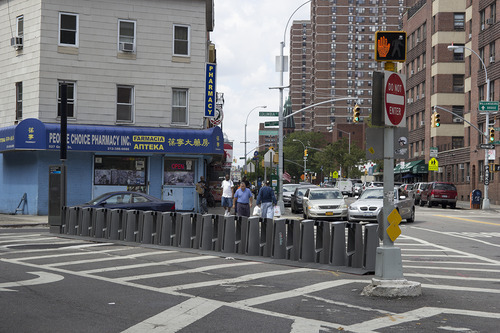
At the intersection of Grand and Henry St. in the Lower East Side, a shiny bike rental station sits empty as waves of bikers and drivers zoom by. The terminal stands out with its chunky metal hubs, painted gray and Citibank blue. On a bright October afternoon, several people trickle by in hopes of renting a Citi Bike bicycle, either for the rest of the day or just a few hours. Most leave disappointed, because every single bike is currently taken. Minutes later, one is returned and a customer swoops in and inserts his bright blue Citi Bike key fob. A green light flashes and the bike unlocks with a click. He adjusts the seat then cruises down Grand St., leaving the stand empty once again.
The stand, open for business since August 28th of this year, is one of hundreds installed since the program began went into effect roughly two years ago. Over the past eight months, Citi Bike has shown a growth explosion, causing a sort of bike-mania across the city. With over 350 stations today, the Department of Transportation plans the total count to reach over 420 by the end of 2013 and 600 at its completion.
These short-term rentals mean there are no concerns about repairs or damages, and no need to buy a bike. Newcomers and experts from all backgrounds use the service as a link between trains and home or work. Mayor Bloomberg, speaking on the day the service was launched, celebrated its advantages: “In addition to expanding our transit network … Citi Bike will also help to make our streets safer,” he said.
But the biggest advantage for users is the price. For only $95 a year, consumers get unlimited access to any station in the city. The program was a positive cultural shift, one that seemed to benefit everyone involved.
But not everyone. Frank’s Bike Shop is one store away from that popular new stand on Grant St. Owner Frank Arroyo rents bikes in addition to sales and repairs, and now business is suffering. He considered the Citi Bike stations a threat from the moment they started to gain popularity. “They just need to get rid of the damned things and be done with it!” he said.
Nestled behind a web of dangling helmets and chains, the middle aged and portly Arroyo hunched over a young girl’s bike, tightening the brakes. Arroyo’s gray shirt was stained with splotches of chain oil, evidence of hours spent with his face inches away from sprockets and cogs. The girl bounced with anticipation. He could have very well sold her parents a bicycle – back when his shop opened in 1976, when his thinning hair was dark and full.
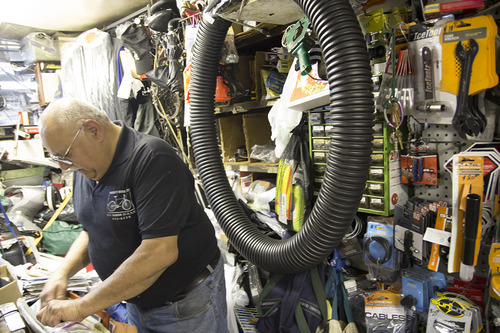
The front of Arroyo’s red brick shop is lined with dozens of multicolored, sparkling bikes available for sale. Through the long glass windows, visitors have seen the business grow to rows and rows of bikes packed from floor to ceiling, each emitting a faint smell of oil or rust, or both.
He took a break from his work to complain about the influx of new terminals, which he’s mentally mapped out with precision. “They’re on Clinton and Grand. They’re on Madison and Montgomery. It’s everything, they’re goin’ in front of the hotels too,” he said. “We can’t compete with these prices!”
A 24-hour rental of Citi Bikes only costs $10, which is far cheaper than the $30 day-rate Frank has successfully charged in the past.
Frank has his supporters, including local high-end bike owners who scoff at the generic models parked at the Citi Bike stands. But renters care mainly about function over prestige, and certainly over the needs of shop owners like Frank.
“I’m doing the most practical thing for me,” said Ryan Mandel, 33, who opted for the yearly plan, and has rented multiple times from Citi Bike Stations on the Lower East Side. Julie Mendez, 27, contrasted the service with the local bike shops. “It’s just so much cheaper than the other way, and I don’t have to use it every day,” she said.
For Arroyo, the fight became especially personal when the Department of Transportation placed a terminal in view of his shop. Neighbors, customers, and other supporters started a petition. As of October, over 1100 signatures have been gathered to remove the terminal near him. But there was no response when the petition was delivered to the DOT.
“I’m starting to think there’s nothing I can do,” Arroyo said.
Other local bike owners are in the same quandary. Martin Werneth is a manager at NYC Velo, a large bike shop in the Lower East Side, roughly a mile from Arroyo’s and just a third of a mile from a Citi Bike station. “Has it affected us negatively? Yes! When they put 6000 or more new bikes in a small area, our sales were affected big time,” he said.
But there is a possible happy ending to Frank Arroyo’s story…in Boston. There, the Hubway program has been in place for two years and has expanded much like the Citi Bike program.
Boston has become a bike town. The city acts as both a promoter and defender of the program, celebrating its millionth ride this July. It currently has 115 stations. With a population of just over 636,000, that’s four times as many bike stations per capita as New York.
But Craig Collins, who manages one of the largest bike stores in Boston, UrbanAdvenTours, experienced an initial dip in sales, much like Arroyo, when Hubway bikes first appeared. “We used to rent like 20,000,” estimates Collins. “Then one day it dropped to 7,000 for about a year,” he said.
Collins, like Arroyo, was frustrated at the time. With the downward trend, UrbanAdvenTours decided to specialize on more unique bicycles such as mountain bikes, expensive street bikes, and children's bikes to increase sales. “We’ve adapted. We’ve changed our model to rent higher quality bikes,” he said. They've also expanded into providing bike tours around the area, as well as deliveries.
Now, Collins says his rentals have recovered. Because Hubway has led to an increase in bike interest and infrastructure, more people are coming through the doors. “I am grateful to them,” Collins said of his Hubway competition. “Because of Hubway, our city streets are safer. It makes bikers noticed and want to try,” he said.
Nicole Freedman is the Director of the Boston City Bike Program, and oversees all Hubway activities. She confirmed there was some initial general backlash from the bike rental shops in Boston, and that it has diminished as the program proved itself to be effective. “At first there was some concern from those shops that rented, but we aren’t in direct competition with them.” She said. “We were really cognizant of the local bike shops and worked with them over time.” Boston also provides a directory of local shops and created a helmet share program with them.
When he was told of the Boston success story weeks after his initial interview, and what it portends for New York, Frank Arroyo became optimistic about the potential for the growth of bike culture in his city. "Now it's building up because more people have gotten more used to being able to ride," he said. “Hopefully things will move on and the sales will be good!” Arroyo is slowly coming to terms with the new reality, and understands the rental business is here to stay. Because of New York and Boston’s success, several other cities such as Portland, Oregon and Atlanta, Georgia are planning their own ride share programs and to expand bike culture to anyone willing to roll on two wheels.
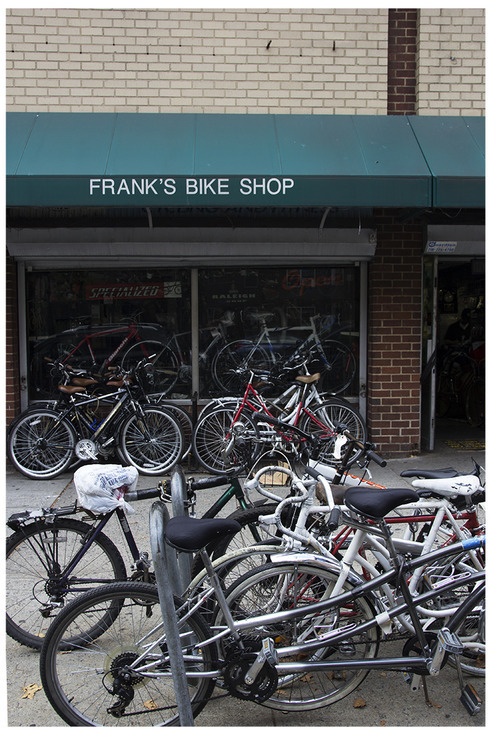
#bike#bikelife#nyc#lower manhattan#bicycles#citi#citi-bikes#franks bike shop#mobility#infrastructure#small business#wheels#spokes#community#local business#columbia#journalism#growth
0 notes
Text
AND...SCENE: NYPD 6th Precinct
By Saman Malik
The NYPD 6th Precinct is an unceremonious building, much like any other on the street.
Large, brown French doors open into the main room of the precinct. On the right hand wall, large gold letters proclaim "The 6th Precinct Memorial Wall of Honor", above seven plaques honoring officers who have died in the line of duty. Red, white, and blue paper wreathes stand next to three flags. An oversized frame on the opposite wall holds letters from children across the country stuck together in the shape of the American flag.
“Wisconsin: ‘On behalf of the youth of America thank you for your strength and dedication to rebuilding the America of tomorrow that we (do) not yet know.’
– Brian Martin, State President Wisconsin Association of Student Councils.”
The waiting area is a small corner sectioned off by low walls. A row of four army-green chairs lines the back wall that hold pamphlets on identity theft, safety tips for the older person and public safety.
The uneven, stained ceiling is dotted with fire sprinklers and a dirty air vent. Sterile white tube lights run vertically across the length of the roof.
There is a faint smell of Lysol or some other cleaning agent.
The police radio scanner broadcasts a stream of muffled alerts, punctuated by abrupt buzzes and beeps.
A dark haired woman, who appears to be in her early 20s, stands at the police desk. She says she is there to file a report against her ex-boyfriend who broke into her apartment earlier that day. Dressed in a sea green blazer over black top, black jeans and wedges, she speaks in measured tones to the police official dressed in plain clothes behind a desk with protective glass all the way up to the ceiling.
The woman says she doesn't intend to press charges but wants to file a report in case things get worse. "I just want something on paper," she says.
A man wearing a white polo shirt, blue jeans and black Nikes standing behind her, identifies himself as the woman’s brother. The police official tells the woman that a domestic officer who does home visits will follow up with them. The pair leaves the building after 40 minutes.
The room echoes with the clicking of a pen, rustling of a newspaper and snippets of a conversation between two female police officers behind the low walls.
"What about the woman who was choked by the daughter?"
“Yeah, I arrested her.”
Someone types in an unseen corner of the room.
A thin female police official with pale skin, short curly hair and dangling earrings, wearing a black suit over a pink blouse asks an officer in uniform, "Is anyone out on patrol? Is anything happening?"
"I've been listening to the radio," says a bald officer nonchalantly. The conversation implies that nothing is in fact happening.
A woman who appears to be in her early twenties, with a high ponytail, dressed in a pink pull over, black leggings and bright pink running shoes comes in to report a lost wallet.
She is taken to a second police official who is not in uniform at the other end of the room.
The atmosphere in the precinct is relaxed and at ease; not what you’d expect from a place where they all carry guns and deal in crime.
A tall officer, in his early 20s with dark cropped hair walks in purposefully with a cup of coffee in his hand. The bunch of keys noisily strikes against the steel handcuffs on his hips. After walking in and out of the room several times, he asks the female police official behind the glass if she wants “in on the pizza.” She looks confused.
“We’re ordering in from Joe’s pizza,” he explains.
0 notes
Text
AND...SCENE: South Street Seaport
By Jasper Rischen
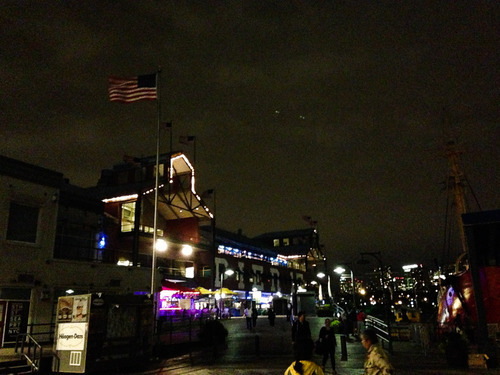
[The neon lights of Pier 17 at the South Street Seaport are on for one last night. On October 1st, demolition of the Sandy-damaged building will begin. September 9th, 2013. Photo by Jasper Rischen.]
“…This is so emotional...”
“…I’ve been coming here for decades!”
Two middle-aged women in floral dresses sit at the bar of Pacific Grill, a waterfront restaurant in the Pier 17 building at the South Street Seaport. Around them waiters carry trays overflowing with seafood to hungry costumers. A giant lobster splashes its tail loudly as a chef takes it out of the storefront aquarium, and off to its final destination behind the metal kitchen doors. The walls of the restaurant bear big wooden swordfish, the ceilings are draped with navy blue sail cloth. The salty air of the Atlantic blows through the open doors, as the ladies reminisce with the bartender about their very first time here. Sometime in the 1980s the building opened, and they proudly say they have been here almost every week since. Today will be their last time.
Pier 17 is a large, three-story structure of dark wood and faded red and white sheet metal. Its barn-like shape houses a shopping mall and restaurants. Its damage from Hurricane Sandy is still visible. Parts of the wooden pier have collapsed and not been repaired. Blue construction canvas covers the gaping wounds in the deck, held together by grey sandbags and steel fences. Paint is chipping off and large storefronts are empty, with old newspapers glued against the glass barring a look inside. Some mom and pop stores inside the mall still operate, selling all the cliché tourist goods - from mugs with a comical drawing of the President to T-shirts screaming “17 Reasons Beer Is Better Than Women.” The cries of babies echo through the halls, while the walls are plastered with “FINAL SALE!” signs. Offers for up to 90% off suggest that many shop owners have not found a new location.
One young shop owner with her black hair in a short ponytail, who looks and sounds of Russian descent, tries to explain to a German customer why her store is clearing out. Naked mannequins lie beheaded on the floor as the woman strips posters off the wall and empties a shaky white magnet display board. A shop owner on the third floor of the current building appears distressed when he tells a customer that he has been here for 25 years, and only got a month’s notice to leave: “It’s like Fifth Avenue is coming down here. They want a five star Gucci mall, so we have to go.”
The ladies at the bar of Pacific Grill decide to capture their last moment in the building with an Instagram video:
“Come on, look sad! More sad! We’re having one sad, last beer on Pier 17.”
They burst out in laughter when they look at their resulting short film. At 9 p.m. tonight, Pier 17 closes for good.

[Many stores were already clearing out on the last day Pier 17 was open for business. September 9th, 2013. Photo by Jasper Rischen.]
1 note
·
View note
Text
A District Divided: City Council Race Between Mendez, Del Rio Heats Up
By Sean Ryon

[A sign promoting Rosie Mendez for City Council District 2 hung on 23rd Street and Second Ave on Sept. 10, 2013. The incumbent Mendez faced off against political newcomer Pastor Richard Del Dio for position. Photo By Sean Ryon]
The air was sticky with heat in the cafeteria at the American Sign Language and English Lower School on 23rd Street and Second Ave. That’s where Gramercy residents lined up to vote in the Democratic primary of the 2013 New York City mayoral election. One race they decided that day would determine who would represent their district in City Council.
On Tuesday September 10, Rosie Mendez and Richard Del Rio squared off in the race for the District 2 City Council seat. It’s one of the less publicized elections that spurred contentious debate between Mendez and Del Rio’s camps. Dan Bauer, a Mendez supporter, says it’s important because in such a local race, the winning candidate will have a tangible impact on the district.
“I think you’ve got to think global and act local,” said Bauer. “That’s where it starts.”
One of the most notable deciding factors of this race was Mendez and Del Rio’s political experience. Mendez has served a total of eight years as the City Councilwoman for District 2 since 2006, making her the projected favorite candidate. She has been endorsed by publications like The Villager and Gay City News, as well as groups like the United Federation of Teachers.
Del Rio, however, was the dark horse contender. He is a pastor-turned-political hopeful who founded the Abounding Graces Ministry in 1982 with his wife. Del Rio has enjoyed local fame for his community organizing efforts, although he has never held public office.
Del Rio’s lack of political experience did not scare off some supporters, however. Daniel Miller, a Del Rio campaigner, said that Del Rio’s grass roots base offered an alternative to the political status quo.
“We basically want to restore the community and create a new culture,” Miller said. “The main thing about Rick is he’s not really a politician; he’s more about the community. He’s a man for the community.”
A number of voters said they were most concerned with City Council’s function and presence in the community. Although many noted they ultimately sided with Mendez, few indicated they did so for a specific reason.
“[The candidates are] not as high profile,” said Kevin Barry, a voter for Mendez. “You really don’t hear very much about [City Council members] in terms of what they’re voting on unless it’s really controversial.”
Gene Parseghian chose a different route: he declined to vote in the City Council District primary. He did not feel comfortable enough with either candidate to make a decision. More importantly, he said that he did not want to side with Mendez just because she was incumbent.
“I wasn’t really sure [of the candidates],” said Parseghian. “I think Rosie Mendez has been in office for a while, but I thought better to just let it go.”
He added, “I wasn’t going to vote for her just because she’s been there.”
0 notes
Text
Voices of…The Village
by Saman Malik

[Dan Hicks, a former resident of the Village in Christopher Street Park, New York. Photo by Saman Malik]
New York’s Village, which once saw the birth of the city’s first-ever gay neighborhood, has evolved into a hotspot for trendy restaurants, celebrity townhouses and ‘Sex And The City’ tour stops.
A wardrobe designer for TV and film, Dan Hicks, 53, used to be a resident of the Village up until four years ago when he moved to Midtown Manhattan.
Sitting on a bench in a gated park area on Christopher Street across from the famed Stonewall Inn, Hicks reminisced about life in the Village.
“I came here in ‘86 and I found my apartment in The Village Voice right down Christopher Street,” he said, remembering how much easier things were in the 1980s.
“You would give them your license and they would give you their keys and you could go look at the places. I don’t think that would ever happen today.”
“I think [the history of the Village] still remains in terms of its gay beginnings,” he said,��pointing to the Stonewall Inn. However, he said he feels that the neighborhood is now occupied by what he calls “the Me Generation”.
Hicks remembered when the Gay Pride Parade would march down Christopher Street and there was a commitment to a cause. “There was a sense of community,” he said.
Today, however he said things are different. He said he feels younger people don’t realize what the previous generation went through and the battles they fought. “Its all Sex And The City and cupcakes now – it’s very different,” he added.

[Dan Hicks, a former resident of the Village enjoys an iced beverage on a hot day in Christopher Street Park, New York. Photo by Saman Malik]
The recent increase in reported hate crimes in The Village comes as a surprise to Hicks.
“It’s sad to hear that that’s still going on and I don’t know where that comes from - where that hate and anger comes from,” he said. ”I think that’s always gone on to a certain extent but I don’t know why that’s happening. I really don’t.”
Despite the generational, cultural and socio-economic changes in the area, Hicks said his fondness for his former neighborhood remains in tact. “I still come back here because I feel comfortable here,” he said.
“It’s probably because I lived here for so long. Midtown doesn’t have the same feeling as down here.”
0 notes
Text
Circus De Blasio
By Jasper Rischen

[Mayoral candidate Bill de Blasio and his wife Chirlane McCray campaign at a subway stop in Brooklyn. September 10th, 2013. Photo by Jasper Rischen.]
“I have emerged from my laboratory!” jokes Bill de Blasio as he opens the black plastic curtains of his voting booth. Shutter sounds fly around him as if he just angered a giant nest of bees. Cameramen and reporters scream at the top of their lungs that he has to stay in that spot just a little longer, smile, look this way – no that way.
“Give me some more room, Jesus!” demands one reporter who tries to re-claim his spot in the front row. “Back up, back up! Come on, back up more!” shouts another journalist as they swarm around De Blasio who works his way towards the exit. The candidate seems to revel in the spotlight, and at the same time purposefully ignores the scene around him. He guides his wife Chirlane McCray through the crowd. They install themselves before wrought iron gates underneath grand columned doors of the maroon-bricked building, for their first press conference of the day.
It’s 7AM at the Public Library in Park Slope, Brooklyn. The sun hasn’t had a chance to peek through the morning haze and most of the brownstones around the large library seem to still be asleep. But this morning, a lively scene is unfolding in this usually unassuming neighborhood. It’s Election Day, and frontrunner Bill de Blasio just cast his own vote in the Democratic primary for Mayor of New York City. Oversized satellite TV trucks are installed near the sidewalk, people on their way to work bump into TV anchors in sharp suits and pastel colored dresses. Reporters check their make-up and hair in the reflection of car windows, before grabbing their microphones as De Blasio walks down the steps of the library.
“Who did you vote for for Mayor?” tries one reporter, but De Blasio doesn’t answer. One thing becomes very clear this morning, and throughout the rest of the day: Bill de Blasio is in control. He doesn’t answer questions if it’s not the right moment. He re-arranges the placement of volunteers at campaign stops if it’s not of his liking. He will tell supporters to lower their voice if their chanting gets a tad too enthusiastic. He seems to direct or delegate every moment on this campaign trail himself.
“Do you want to meet the next mayor of New York City? He’s right there!” At the first campaign stop of the day, a subway station on Franklin Avenue in Brooklyn, team De Blasio preps travellers as they walk up the subway stairs. It’s a somewhat intrusive greeting for some, who turn away as soon as they reach the top of the stairs, often ignoring a handshake from the candidate himself. De Blasio decides to move everyone a couple steps back, to “open it up more”. It seems to works: most people who now exit the train station hug the candidate in excitement or at least quietly take a flyer from his staff. One woman still tries to sneak out, but De Blasio himself gets her attention by loudly complimenting her on her bright purple dreadlocks. The flattered woman decides to come back and snap a photo with the candidate.
De Blasio’s wife Chirlane is constantly by his side and today they are joined by their daughter Chiara on a ferry ride to Staten Island. De Blasio’s wife is African American, and the bi-racial family has been featured prominently in the campaign. It is a move that has earned De Blasio both praise and criticism, which came to a boiling point on September 7th, just days before the primary. Mayor Bloomberg said in an interview with New York Magazine that De Blasio was running a “racist” campaign, adding that “he’s making an appeal using his family to gain support.” At a campaign stop on 96th street and Broadway, Bill de Blasio responds to Bloomberg’s criticism, saying: “I think his comments the other day were very unfortunate: obviously uncalled for. I think it is astounding that a sitting mayor of this city would say such a thing.”
Diana Denado, a 49 year old voter who had just shaken De Blasio’s hands, fumes a little less subtly from behind her sporty sunglasses: “I think Bloomberg should shut the f*&$ up, I think he is a jealous, miserable millionaire. De Blasio is a proud family man and that’s one of the reasons I voted for him.” Behind Ms. Denado, Bill De Blasio wraps up the last handshakes and photos. Circus De Blasio is off to the next stop, and the candidate seems to be both the star and director of the show.

[Bill de Blasio triumphantly exits his voting booth at the Park Slope Public Library. September 10th, 2013. Photo by Jasper Rischen.]
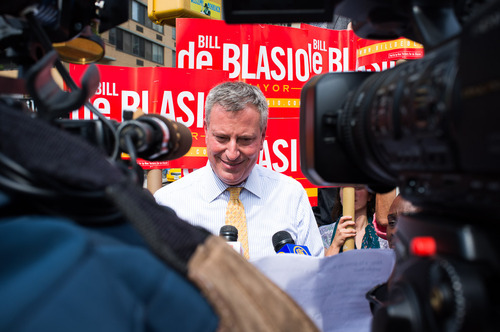
[De Blasio speaks with reporters during a campaign stop on 96th Street and Broadway. September 10th, 2013. Photo by Jasper Rischen.]

[De Blasio jokes around with TSA officers while campaigning at a subway stop in Brooklyn. September 10th, 2013. Photo by Jasper Rischen.]
0 notes